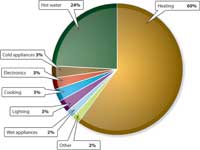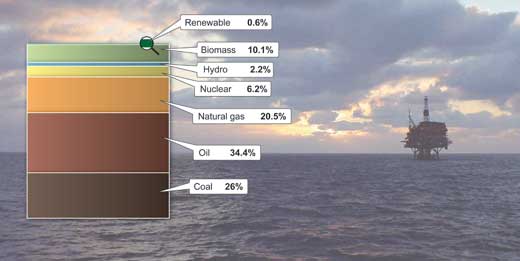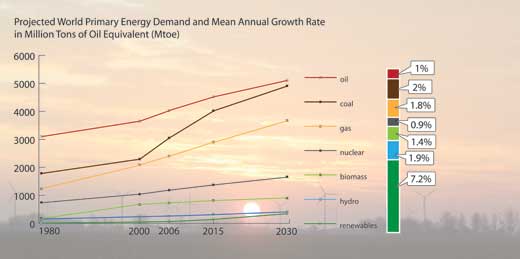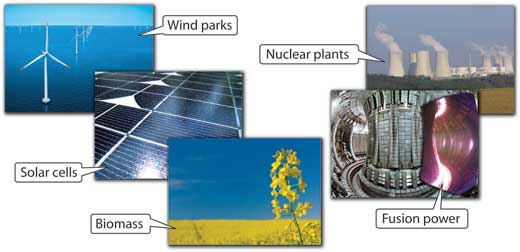Powering the world Understand article
Energy – why is it so important, where do we get it and how much do we use? Gieljan de Vries from the Dutch FOM-Institute for Plasma Physics Rijnhuizen investigates.

household. Heating rooms and
water takes up most of the energy.
Lighting takes up only 3% of the
power requirements, so installing
energy-saving fluorescent lamps
has a limited impact. Preventing
heat loss by better building
insulation saves a lot more energy.
Data source: Department of Trade
and Industry, UK.
Click to enlarge image
Image courtesy of Gieljan de Vries
Forget the dollar, the euro, and the yen. If you want to get anything done in the world, you need to spend energy. Moving a car, powering a computer or creating something in a factory – all these things require energy. So what is energy, and how does it shape our world?
Physicists define energy as the ability to do work. That’s a pretty abstract definition, because the concept of energy applies to so many different situations and materials. Pick any task, and you can calculate the total amount of energy in joules (J) that is needed to complete it, or the power (energy per second) that a process consumes in watts (W; equal to J/s). It turns out that every aspect of our lives has an energy price we have to pay.
Humans use energy all the time. Just sitting there, your body needs around 100 W of power. Energy powers muscles such as your heart and enables biochemical reactions in your organs. Of course, people do more than just sit around. Walking up the stairs or lifting boxes, we can produce around 100 W of useful power for hours on end. However, to do so, our muscles will consume 300-400 W – three to four times the energy they produce. A European household of three to four people continuously consumes an average of about 400 W by running heaters, powering electrical devices and so on. It would take twelve people on treadmills (four per shift in three shifts of eight hours) to provide that much power.
Twenty thousand hours of work
Luckily, we don’t have to resort to slave labour to generate energy. Instead, roughly 81% of our energy needs are met by the chemical energy contained in fossil fuels: oil, gas and coal. It’s basically solar energy, absorbed by growing plants millions of years ago. After the plants die and become buried under new layers of earth, the underground heat and pressure turn the dead cells into long, energy-rich molecules.

Image courtesy of Gieljan de Vries
Coal, oil and gas are used in roughly equal quantities to generate the world’s energy needs, but oil has perhaps the most visible use of the three: all kinds of transportation are utterly reliant on the fuels produced from it. Burning a standard barrel of oil, holding 159 litres, will release around 6100 MJ (million joule) of energy. Not only is that a lot of energy, it’s also unbelievably cheap. Even though the price for a barrel of oil has fluctuated between €30 and €150 in the past year, a human would have to perform hard labour for 22 000 hours to release the amount of energy contained in one barrel. That’s 11 years spent on a treadmill every workday from 9 am to 5 pm. Good luck finding anyone who would work that long and hard for that kind of money!
Back to our average energy use: we need more than the 100 W each person minimally consumes or the 400 W powering our house to maintain our way of life – consider the energy used to produce and transport household appliances in the first place. It turns out that a nation’s households are responsible for about a quarter of its energy use, with transportation and industry each responsible for another third. Businesses, infrastructure and agriculture fill out the list of energy consumers.
A lake of oil
Let’s put things into perspective: in 2006, the European Union used 49.2 TJ (terajoule) of energy. That’s 49 million million joule, a truly staggering amount. Even spread out over 500 million Europeans, our yearly energy consumption is huge: 95 800 MJ for each of us (about 16 barrels of oil). For the whole of Europe, we would have had to burn the equivalent of 1176 million tons of crude oil to release that much energy, enough to fill a lake 20 metres deep and 20 by 30 kilometres wide. And that’s just to satisfy the annual European demand for energy. That year, the USA used the equivalent of 2340 million tons of oil and China burned up 1717 million tons. China’s energy use has increased spectacularly since their fast economic growth began. But counted per citizen, China is still not a wasteful energy user: each Chinese citizen uses the equivalent of 1.3 tons of oil per year. A US citizen, however, uses 7.4 tons of oil, and a European averages at 3.7 tons per year.

Image courtesy of Gieljan de Vries
Every year, a fleet of 3500 oil tankers, some of them 400 meters long, ships 2000 million tons of oil across the globe. That’s not all of the oil we use, because pipelines transport another part of the load. In 2006, the world used 3481 million tons of oil, providing 43% of the worldwide energy demand.
Those numbers are huge and they’re not coming down. According to rough estimates, in 2100 the world will need four times the amount of energy it is using today. In the course of this century, China, India and other developing nations are expected both to grow in population size and to bring their energy consumption per citizen up to European levels. That’s four billion people who are going to need as much energy as the average European uses right now. And we can’t blame them.
Energy is linked to the standard of living
For most of the world, energy is not something you want to use less of, but something very desirable to fulfil basic needs. Easy access to electricity and drinking water is everyday reality to most of us. For two-thirds of humanity, it’s a precious, unaffordable luxury. Without electric lights, there’s only so much work you can do in one day. Without the energy needed to purify and transport water, people in developing countries need to walk miles to the nearest clean well. Walk, because they often lack bicycles or well-constructed roads to speed up travel.
You can only improve your standard of living if you have energy to spend. Electric lights allow for longer workdays, diesel fuel powers heavy machinery for building roads, constructing buildings or aiding in farming. With enough energy, factories can produce consumer goods, and trucks running on fossil fuels can transport them. Energy makes life easier.
We only have to look at the poorest of countries to see that our lifestyle absolutely depends on easily available energy: we need energy to manage our water supply, but it also enables irrigation and the production of chemical fertilisers, which help feed the population. We use energy to heat or cool our homes and for easy transportation. Energy keeps factories and cities running, providing jobs for millions of people. Where energy becomes scarce, these things we take for granted become expensive – the perks of the rich. The reverse is also true: a country that can make more energy available to its population can improve their general quality of life. Of course, energy isn’t a miracle cure for problems in Africa, but not having energy does make them that much harder to solve.
Wanted: new sources of energy

Public domain image; image source: Wikimedia Commons
The world demands more energy. In the short term, this means more use of fossil fuels. Polluting coal plants, previously unpopular, are now built to the tune of one every week in China. The demand for oil alone is projected to rise by 47% by 2030, and companies search the harshest of environments, such as the deep sea or the arctic, for natural gas to fuel power plants and factories. According to the International Energy Agency (IEA), these investments will keep the share of fossil fuels around 81% of the energy mix. In absolute terms, the total energy requirements – and, because of that, the demand for fossil fuels – is expected to rise by almost a half in 2030.
One day, the fossil reserves will run out. Coal mines can last roughly another 200 years at the current rate of use. Oil production, some fear, has already peaked: the IEA is afraid that existing oil fields are producing less and less each year, and too few new fields are being discovered to stop the slow decrease in production. We’re going to need sustainable forms of energy if we want to prevent conflict over the diminishing reserves. Besides, the way fossil fuels increase climate change through the greenhouse effect is very worrying, and calls for sustainable sources of energy.
Fortunately, work is already underway to change the way we power our world. Energy harvested from sunlight, wind and hydro-power, and even the heat from Earth’s core are slowly adding to fossil fuels. Promising energy sources, such as nuclear fusion, are being investigated by scientists (see Warrick, 2006). Have we started to develop these sources on time? Or will the future be energy-starved? Science in School will investigate alternative sources of energy in upcoming issues. Read carefully – these technologies are going to change the world. To test alternative energy sources in the classroom, see Dudley Shallcross and colleagues’ article in this issue (Shallcross et al., 2009).
Big numbers
When talking about the energy consumption of everyone on Earth, the numbers go through the roof. Here’s a small list to help you keep track of things. From left to right, you’ll find a number, what it’s called, a shorthand scientific notation for the number of zeroes after the leading digit, and finally the prefix normally used.
| Number | Name | Shorthand | Prefix |
|---|---|---|---|
| 1 000 000 | a million | 106 | mega (M) |
| 1 000 000 000 | a billion | 109 | giga (G) |
| 1 000 000 000 000 | a trillion | 1012 | tera (T) |
| 1 000 000 000 000 000 | a quadrillion | 1015 | peta (P) |
| 1 000 000 000 000 000 000 | a quitillion | 1018 | exa (E) |
For example, in 2005 the total energy consumption of everyone on Earth was the equivalent of 7 912 million tons of oils. These 6.5 billion, or 6.5 x 109, people used 331 259 616 terajoules (TJ), roughly 331.26 x 1018 = 331.26 exajoules (EJ).
References
- Shallcross D, Harrison T, Henshaw S, Sellou L (2009) Fuelling interest: climate change experiments. Science in School 11: 38-43.
- Warrick C (2006) Fusion – ace in the energy pack? Science in School 1: 52-55.
Web References
- w1 – The website of the Dutch FOM-Institute for Plasma Physics Rijnhuizen can be found here: www.rijnhuizen.nl
Resources
- Background reading
- The article ‘Future Global Energy Prosperity: The Terawatt Challenge’ by Richard E. Smalley of Rice University can be downloaded from the Rice University website (http://cohesion.rice.edu) or here: www.tinyurl.com/dg25b
- The Hirsch report (Peaking of World Oil Production: Impacts, Mitigation, and Risk Management), created by request for the US Department of Energy and published in February 2005, can be downloaded from the Atlantic Council website (www.acus.org) or here: www.tinyurl.com/8yebs
- Energy statistics
- The International Energy Agency (IEA) provides energy and population statistics. Choose a country or region, then click on ‘Indicators’: www.iea.org/Textbase/stats/index.asp
- The IEA’s Key World Energy Statistics can be downloaded here: www.iea.org/Textbase/publications/free_new_Desc.asp?PUBS_ID=1199
- BP has provided a Statistical Review of World Energy in 2008: www.bp.com/productlanding.do?categoryId=6929&contentId=7044622
- The following report summarises the energy subsidies in the European Union in 2004: www.eea.europa.eu/publications/technical_report_2004_1
Review
Experts in the field of science education emphasise that energy is a tricky topic. In addition, it is not easy for students to comprehend the significance of energy in life. Their interest may pick up when they come to realise that without electricity or fuels, they would not have MP3 players, PCs, TVs, Internet – nor would they have the basic comforts usually taken for granted, such as lighting, heating or cars. Moreover, it is important for the citizens of tomorrow to understand the vital role of energy, the environmental problems that the increased consumption of fossil fuels creates, and the urgent need for sustainable forms of energy.
In this article, Gieljan de Vries talks about the importance of energy, providing interesting and motivating information and numbers on the current and future needs for huge amounts of energy. This article combines environmental, science and economic issues: energy as a topic lends itself to a large variety of interdisciplinary and cross-curricular teaching opportunities.
Vangelis Koltsakis, Greece





